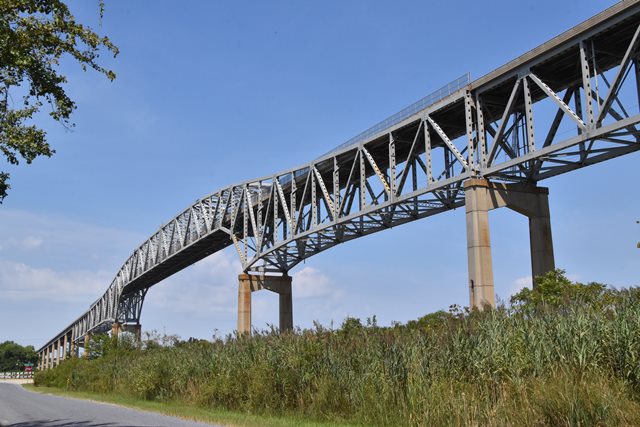We Recommend:
Bach Steel - Experts at historic truss bridge restoration.
BridgeHunter.com Phase 1 is released to the public! - Visit Now
Reedy Point Bridge

Primary Photographer(s): Nathan Holth
Bridge Documented: July 1, 2016 and August 31, 2019
Rural: New Castle County, Delaware: United States
Metal Cantilever (Arched) 18 Panel Bolt-Connected Warren Through Truss, Fixed and Approach Spans: Metal 8 Panel Bolt-Connected Warren Deck Truss, Fixed
1968 By Builder/Contractor: John F. Beasley Company of Dallas Texas and Novo Industrial Group of Chicago Illinois (Beasley-Nova Joint Venture) and Engineer/Design: Modjeski and Masters
1985
600.0 Feet (182.9 Meters)
8,432.5 Feet (2570.2 Meters)
25.6 Feet (7.8 Meters)
3 Main Span(s) and 64 Approach Span(s)
1496002

View Information About HSR Ratings
Bridge Documentation
The Chesapeake and Delaware Canal, like many canals that still function today, has a long history. It originally went through Delaware City until that section was realigned in the mid-1920s and a vertical lift bridge was constructed in this area. This bridge was replaced by the current high level fixed bridge in 1968. This bridge is a late but noteworthy example of a form of cantilever truss that is carefully designed to eliminate pointy towers at the piers and instead offer an arch-like appearance, consisting of a deck truss span that transitions into a through truss span. This variety of cantilever truss was intended to offer better aesthetic qualities and started to be built in the 1930s. They are less common than other styles of cantilever truss. Typical of late 1960s construction, this bridge used rivets in the shop and bolts for field assembly. Thus the connections are bolted, and the built-up beams are riveted. Also typical of this period, very little v-lacing or lattice is present on built-up members. One simple span deck truss approach span is located at each end of the three span cantilever truss, with the remaining approach spans being deck plate girder and stringer spans.
View Archived National Bridge Inventory Report - Has Additional Details and Evaluation
View Historical Articles About This Bridge
![]()
Photo Galleries and Videos: Reedy Point Bridge
Bridge Photo-Documentation
Original / Full Size PhotosA collection of overview and detail photos. This gallery offers photos in the highest available resolution and file size in a touch-friendly popup viewer.
Alternatively, Browse Without Using Viewer
![]()
Bridge Photo-Documentation
Mobile Optimized PhotosA collection of overview and detail photos. This gallery features data-friendly, fast-loading photos in a touch-friendly popup viewer.
Alternatively, Browse Without Using Viewer
![]()
Maps and Links: Reedy Point Bridge
Coordinates (Latitude, Longitude):
Search For Additional Bridge Listings:
Bridgehunter.com: View listed bridges within 0.5 miles (0.8 kilometers) of this bridge.
Bridgehunter.com: View listed bridges within 10 miles (16 kilometers) of this bridge.
Additional Maps:
Google Streetview (If Available)
GeoHack (Additional Links and Coordinates)
Apple Maps (Via DuckDuckGo Search)
Apple Maps (Apple devices only)
Android: Open Location In Your Map or GPS App
Flickr Gallery (Find Nearby Photos)
Wikimedia Commons (Find Nearby Photos)
Directions Via Sygic For Android
Directions Via Sygic For iOS and Android Dolphin Browser
USGS National Map (United States Only)
Historical USGS Topo Maps (United States Only)
Historic Aerials (United States Only)
CalTopo Maps (United States Only)

